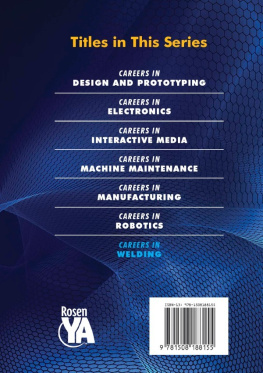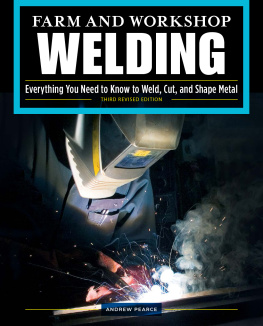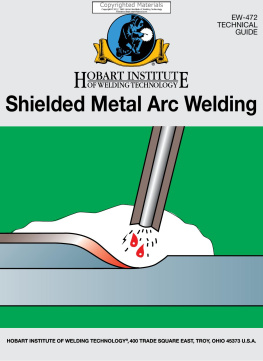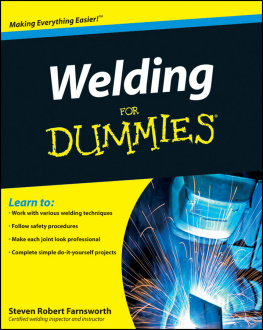About the Author
Jackson Morley pursued his interest in design and fabrication while studying industrial design at the University of Kansas, where he gained experience with MIG welding and fabrication techniques including working with sheet metal blacksmithing. Mr. Morley is involved at an industrial arts organization called the Steel Yard, which is best known for creating unique public art and offering courses in welding, blacksmithing, ceramics, and more. He teaches sheet metal forming, bicycle maintenance, and MIG welding courses that instill creative problem-solving techniques, work-smart practices, and efficient design principles using new and recycled materials.
Technical Reviewer
Randy Shapiro was born and raised in Rhode Island, and graduated from the Thielsch Engineering School of Welding in the spring of 2009 with his American Welding Society certifications in SMAW, GMAW, and GTAW. He currently owns and operates a full-service fabrication business in Cranston, Rhode Island.

Copyright 2013 by McGraw-Hill Education, LLC. All rights reserved. Except as permitted under the United States Copyright Act of 1976, no part of this publication may be reproduced or distributed in any form or by any means, or stored in a database or retrieval system, without the prior written permission of the publisher.
ISBN: 978-0-07-179969-0
MHID: 0-07-179969-9
The material in this eBook also appears in the print version of this title: ISBN: 978-0-07-179968-3, MHID: 0-07-179968-0.
All trademarks are trademarks of their respective owners. Rather than put a trademark symbol after every occurrence of a trademarked name, we use names in an editorial fashion only, and to the benefit of the trademark owner, with no intention of infringement of the trademark. Where such designations appear in this book, they have been printed with initial caps.
McGraw-Hill Education eBooks are available at special quantity discounts to use as premiums and sales promotions, or for use in corporate training programs. To contact a representative please e-mail us at bulksales@mcgraw-hill.com.
McGraw-Hill Education, the McGraw-Hill Education logo, TAB, and related trade dress are trademarks or registered trademarks of McGraw-Hill Education, LLC and/or its affiliates in the United States and other countries and may not be used without written permission. All other trademarks are the property of their respective owners. McGraw-Hill Education is not associated with any product or vendor mentioned in this book.
Information contained in this work has been obtained by McGraw-Hill Education, LLC from sources believed to be reliable. However, neither McGraw-Hill Education nor its authors guarantee the accuracy or completeness of any information published herein, and neither McGraw-Hill Education nor its authors shall be responsible for any errors, omissions, or damages arising out of use of this information. This work is published with the understanding that McGraw-Hill Education and its authors are supplying information but are not attempting to render engineering or other professional services. If such services are required, the assistance of an appropriate professional should be sought.
TERMS OF USE
This is a copyrighted work and McGraw-Hill Education, LLC and its licensors reserve all rights in and to the work. Use of this work is subject to these terms. Except as permitted under the Copyright Act of 1976 and the right to store and retrieve one copy of the work, you may not decompile, disassemble, reverse engineer, reproduce, modify, create derivative works based upon, transmit, distribute, disseminate, sell, publish or sublicense the work or any part of it without McGraw-Hill Educations prior consent. You may use the work for your own noncommercial and personal use; any other use of the work is strictly prohibited. Your right to use the work may be terminated if you fail to comply with these terms.
THE WORK IS PROVIDED AS IS. McGRAW-HILL EDUCATION AND ITS LICENSORS MAKE NO GUARANTEES OR WARRANTIES AS TO THE ACCURACY, ADEQUACY OR COMPLETENESS OF OR RESULTS TO BE OBTAINED FROM USING THE WORK, INCLUDING ANY INFORMATION THAT CAN BE ACCESSED THROUGH THE WORK VIA HYPERLINK OR OTHERWISE, AND EXPRESSLY DISCLAIM ANY WARRANTY, EXPRESS OR IMPLIED, INCLUDING BUT NOT LIMITED TO IMPLIED WARRANTIES OF MERCHANTABILITY OR FITNESS FOR A PARTICULAR PURPOSE. McGraw-Hill Education and its licensors do not warrant or guarantee that the functions contained in the work will meet your requirements or that its operation will be uninterrupted or error free. Neither McGraw-Hill Education nor its licensors shall be liable to you or anyone else for any inaccuracy, error or omission, regardless of cause, in the work or for any damages resulting therefrom. McGraw-Hill Education has no responsibility for the content of any information accessed through the work. Under no circumstances shall McGraw-Hill Education and/or its licensors be liable for any indirect, incidental, special, punitive, consequential or similar damages that result from the use of or inability to use the work, even if any of them has been advised of the possibility of such damages. This limitation of liability shall apply to any claim or cause whatsoever whether such claim or cause arises in contract, tort or otherwise.
Contents
Preface
W elding is a process that is responsible for the creation of much of our modern world but is shrouded in mystery and I think generally misunderstood. This is not all that surprising, reallyafter all, its only been around in its current form since the advent of electricity. Weldings mysterious status is only enhanced by the required safety equipment; it can make just about anyone look quite intimidating. (But isnt that part of the appeal?) Without welding, the modern car, skyscraper, airplane, bridge, and ship wouldnt be possible. Its pretty amazing to think about how recently welding technology has evolved and that now just about anyone can create a decent weld in less than a few hours.
People who want to learn to weld come from all walks of life. At the Steel Yard, where I got my start teaching metalinert gas (MIG) welding courses as an assistant to Howard Sneider, our classes consisted of students ranging in age from 15 years old into their seventies. Enrollment was split right down the middle of the gender line, occasionally with more female students. These students became interested in welding in every way imaginable. Some had a specific project in mind, such as a skateboard grinding rail or a musical instrument; some wanted to learn welding as a possible career choice; and others wanted something fun and creative to do in retirement. Some students were looking for a memorable way to spend the Mothers Day weekend (at our Welding with Mom Workshop), and other students with an arts background just wanted to add welding to their repertoire. However, Id say that the majority of students shared one thing in common: They had at some point become fascinated by welding and were looking for a way to get behind a MIG welder to see what they could do.
In those classes, I learned how to make welding accessible. I learned how to communicate the trickier aspects of welding in simple terms that made the whole process click for my students. I learned a lot about the difficulties first-time welders face and how to help my students overcome these challenges. I also created a number of small projects that introduce basic principles slowly and challenge the welder. My hope is that by following along with this book, your understanding of welding and metalwork will greatly improve, enabling you to think about the world in new ways and create freely.
Next page








